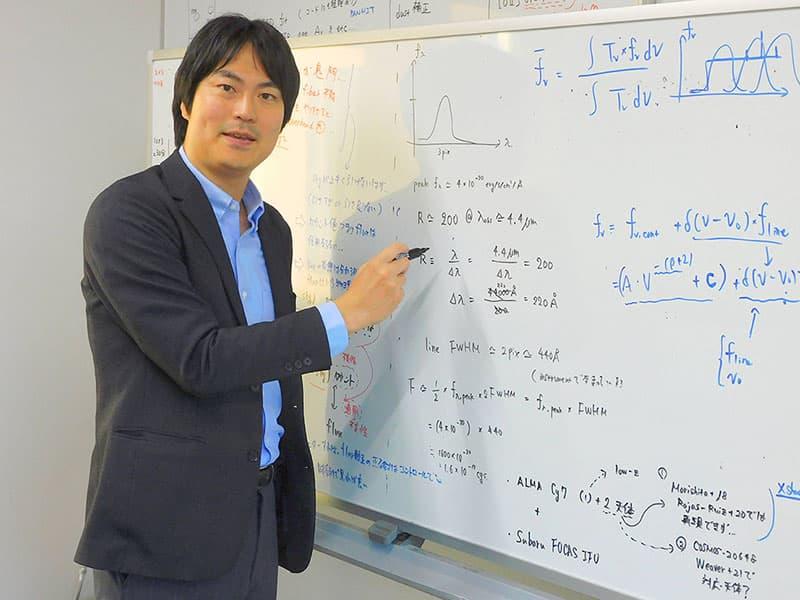TSUKUBA FUTURE
#124 Observations Reveal the Reality of the Early Universe
Associate Professor HASHIMOTO Takuya, Institute of Pure and Applied Sciences

The universe came into existence 13.8 billion years ago, transforming into a seething fireball of extreme temperature and pressure in a monumental event known as the Big Bang. Following this explosive birth, the universe expanded, gradually cooled down, and gave rise to the formation of stars and galaxies—stellar assemblies.
In the contemporary cosmological framework, this narrative unfolds as an early genesis of the universe. However, a pressing question lingers: When did the inaugural galaxies emerge, and how did they evolve? Recent strides in observational technology, exemplified by instruments such as the colossal ALMA radio telescope in Chile and South America, and the James Webb Cosmic Telescope, now allow humanity to capture the glimpses of this cosmic tapestry. HASHIMOTO, among those delving into the fundamental mysteries of the universe, consistently unveils new insights.
Recalling a pivotal moment, HASHIMOTO highlights the groundbreaking paper published in Nature in May 2018 as the pinnacle of his research career. During his tenure as a postdoctoral researcher at Osaka Sangyo University, HASHIMOTO and Associate Professor INOUE Akio (now at Waseda University) and collaborators made a significant discovery. Their findings, facilitated by the ALMA telescope, revealed the presence of oxygen in a galaxy situated a staggering 13.28 billion light-years away, the farthest galaxy where oxygen had been observed.

Future projection of the densely populated part of the proto-cluster of galaxies (depicting its appearance in tens of millions of years)

Imaginary representation of a densely populated proto-cluster of galaxies captured by HASHIMOTO's group
The implications of this discovery are twofold. First, distance itself signifies a temporal aspect. The time taken for light and radio waves to traverse vast cosmic expanses means that observing a galaxy 13.28 billion light-years away translates to witnessing it as it existed 13.28 billion years ago, merely 500 million years post the universe's birth. Consequently, this study marks an observation of the oldest galaxies known to contain oxygen.
Second, oxygen detection is pivotal. In the aftermath of the Big Bang, the universe predominantly comprised light elements such as hydrogen. The formation of heavier elements, such as oxygen, occurred through nuclear fusion processes that transpire within stars born from hydrogen. Observations led by HASHIMOTO reveal that approximately 500 million years after the universe's inception, stars had already generated substantial amounts of oxygen. Drawing on various observational data, HASHIMOTO and his team estimated that active star formation in this particular galaxy commenced 250 million years after Big Bang.
"When we commenced our research, the notion of detecting oxygen from a galaxy at such a vast distance was met with skepticism," recollects HASHIMOTO. "Additionally, securing observation time with the ALMA telescope posed a significant challenge. The excitement was palpable when the results of the observations finally arrived--I was so enthused that sleep eluded me."
Beyond this milestone, HASHIMOTO's team extended their gaze to the cosmic dance of galaxies, focusing on galaxy clusters—aggregations bound together by gravity. Using the James Webb Space Telescope and ALMA, they successfully observed a primordial galaxy clusters situated at mind-boggling distance of 13.14 billion light-years. These observations revealed dense clustering of many galaxies within a confined region, indicating a rapid cycle of stellar birth and demise. The presence of dust in three out of the four galaxies within the dense protogalactic cluster, in stark contrast to the absence of dust outside this cluster, further enriches our understanding of these cosmic formations.

HASHIMOTO engaging in in-depth discussions on his research topic with students in his seminar
When a massive star concludes its life cycle, it becomes a supernova, dispersing a variety of elements. These elements amalgamate to create dust, which subsequently serves as building blocks for new stars. In essence, the life and death cycles of stars transpire more swiftly in densely populated regions where dust is prevalent, in contrast to less congested areas.
Examinations of nearby galaxies have unveiled that the life and death cycles of individual stars accelerate in environments characterized by closely packed galaxies—a phenomenon recognized as the "environmental effect." HASHIMOTO's research has disclosed that this effect was already manifested in a galaxy cluster approximately 700 million years prior to the universe's inception. Furthermore, through simulations, they predicted that these four galaxies would coalesce into a singular, larger galaxy within tens of millions of years.

"I enjoy chasing elusive mysteries," says HASHIMOTO
This groundbreaking research earned recognition as a Notable Research Project at the Autumn Meeting of the Astronomical Society of Japan in September 2023.
HASHIMOTO's investigations shed light on a dynamic early universe where stars experience active birth and demise and galaxies engage in a cycle of collisions and mergers.
His fascination with space traces back to elementary school when the sight of Comet Hale-Bopp, reputedly the largest comet ever observed, kindled his interest in the cosmos. Exposure to space-illustrated books introduced him to the captivating world of galaxies, motivating him to study distant and historical galaxies.
"I derive pleasure from pursuing enigmatic mysteries. My aim is to persist in unraveling the intricacies of the early universe, encompassing the formation of stars and galaxies, contributing to the broadening of humanity's intellectual horizons," expressed HASHIMOTO.
Affiliated with the Tomonaga Center for the History of the Universe, HASHIMOTO is part of an initiative to observe dark galaxies and other celestial entities in the distant universe. This endeavor involves the construction of a 10-meter class electric field telescope in Antarctica's interior plateau region. Antarctica, characterized by minimal atmospheric water vapor and high sky clarity, has proven to be the optimal location for radio wave observations. Plans for installing a small radio telescope with a 30 cm aperture in Antarctica have been formulated. HASHIMOTO and his team anticipate further success in their endeavors.
Article by Science Communicator at the Bureau of Public Relations


